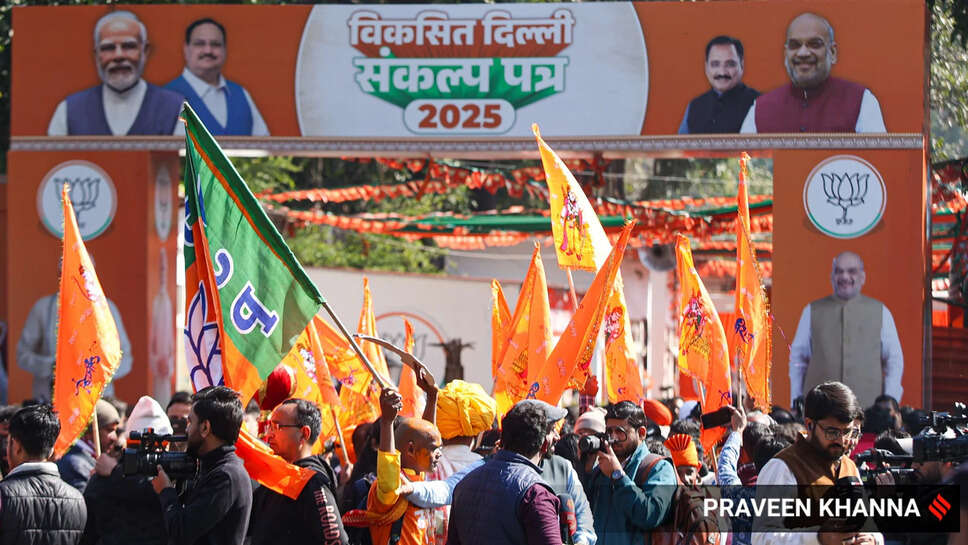Spring Back in Its Step: BJP Maps Out Challenges and Poll Battles Ahead

A series of electoral setbacks earlier this year, the BJP appears to have regained momentum, demonstrating renewed energy and organizational depth. As it navigates upcoming assemblies and parliamentary contests—from state polls in key regions to the all-important national narrative—the party is recalibrating strategy across leadership, messaging, and outreach. This comprehensive exploration delves into how the BJP is positioning itself for a year of electoral testing, the hurdles it must clear, and projections on its campaign blueprints.
🔄 Regaining Political Equilibrium
Until recently, the BJP had experienced a pause in its forward march—a result of regional alliances turning hostile, urban discontent, and internal dissent. But a string of by-election wins and recovered vote shares in local polls have sparked a sense of revival. Couple that with a refreshed cadre outreach and assertive leadership events, and the party’s rhythm now seems more dominant again. This “spring back” is being read by cadres and analysts alike as early signs of regained political agility.
🗳 State Theatre: Multiple Fronts
Himachal Pradesh & Jharkhand
Spring brings Himachal and Jharkhand into sharp focus, with assembly polls poised to test the BJP’s regional penetration. In Himachal, performance on rural economy, employment, and welfare schemes now define public mood, while Jharkhand’s tribal populations and urban middle classes form competing priority groups. The BJP’s challenge lies in delivering development without fracturing social coalitions.
Chhattisgarh, Rajasthan, and Madhya Pradesh
Looking ahead into autumn, these large-assembly states carry national-stakes weight. Rajasthan requires the BJP to reconcile local factionalism, while Chhattisgarh poses tribal-population complexities. In Madhya Pradesh, the incumbent augmentative incumbency narrative must be sharpened to fend off revived opposition momentum. Unity, local alliances, and issue-based campaigning will be essential tools.
💬 Revamped Messaging Strategy
After facing criticism for over-reliance on polarizing themes, the BJP has begun softening its rhetoric, doubling down on tangible governance messaging. Here’s the revised messaging blueprint:
-
Development Narrative: Schemes like affordable housing, rural electrification, health insurance, and support for small businesses take central stage.
-
Local Deliverables: Campaigners focus on water conservation, local roadworks, and welfare enrollment rather than grandiose national projects.
-
Inclusivity: A nuanced attempt to address women voters, youth demographics, tribal communities, and urban middle-class concerns to diversify appeal.
-
Constructive Politics: A calmer tone on opposition issues, with minimal communal provocation and less air-time to confrontational rhetoric.
This subtle shift aims to reset public perception from ideological crusade to governance competence.
👥 Leadership Reorganization
Talking hard or talking local? The BJP is hedging on both. National campaigns will lean on stalwarts like Modi and Shah, but real political impact now lies in strong regional figures: the likes of Pushkar Singh Dhami, Mohan Yadav, and Vishnu Deo Sai are being projected as state powerhouses. This approach underlines the party’s federated model, where national messaging combines with local leadership as a culture of empowerment.
The party has also deepened social engineering efforts by actively coaching lower-rung leaders on digital outreach, polling analysis, and localized campus-style campaigning. This decentralized model allows adaptability to local priorities while maintaining strategic consistency.
📉 Damage Control: Covid Backlash and Inflation Blues
The pandemic-era political rebound posed governance challenges regarding oxygen-crisis chaos and migrant distress. Comparatively, recent inflation trends—particularly in fuel, oil and essentials—have dampened household overs. The BJP’s response involves rolling out support mechanisms like monthly subsidies, direct benefit transfers, and emphasizing fiscal discipline to rebuild economic trust.
Additionally, robust communication lines have been opened to handle flood-related damage assessments, urban sanitation issues, and protests over land acquisition. Rapid damage assessment units now follow government schemes almost in real time to resolve public grievances before they escalate into electoral liabilities.
✍️ Opposition Landscape and Coalition Watches
For BJP, opposition unity is both an asset and a concern. Fragmented opposition often weakens vote consolidation, but piecemeal alliances—like in Karnataka—can surprise. Aware that traditional vote banks like Dalits, Muslims, and disenchanted OBCs can unify, the BJP is ramping up outreach. Constitutional safeguard assurances through schemes and communal harmony events are being rolled out to pre-empt any faith-based realignments.
Equally important is the ongoing social engineering of poor voters, artisans, small traders, and coaches across overlapping caste networks. By pulling levers of representation or leadership in disadvantaged communities, the BJP hopes to undermine potential opposition fronts before they take shape.
🧱 Institutional Strengthening
Beyond campaigns, the BJP’s organizational bodies are being fortified. Enhanced training modules for booth-level workers, digital platforms for real-time reporting, and candidate profiling systems aim to sharpen detection of emerging voter issues. Financial transparency tools are being rolled out to address compliance and funding gaps—especially following recent scrutiny about spending thresholds.
Grassroots metrics are being tracked more granularly than before—tracking family contact, local influencer engagement, and timely resolution of constituency-level complaints. It is a systematic attempt to marry big data with Bharat-scale reach, pushing the party beyond mere national rhetoric into hyper-local responsiveness.
📊 Electoral Financing and Media Strategy
The BJP’s war chest is robust following corporate contributions and strengthened monetization of digital platforms. Funds are being allocated operationally across states based on bellwether modeling—early polling patterns and swing region detection systems guide budget allocation.
Media planning has also been upgraded. Regional digital content teams are fashioning targeted scripts in local languages, emphasizing local victories and emotional appeals. Social media campaigns now focus on lifestyle solutions—like education, pollution control, agricultural productivity—while balancing national pride with local priorities. Offline events—like tractor parades in farm belts and factory inaugurations in growth zones—complement these media efforts.
🌐 International and Security Posturing
On foreign policy, the BJP is playing to strengths: projecting India’s global standing with partnerships, defence acquisitions, space missions, and diaspora outreach. These themes reinforce urban middle-class confidence and national pride. Security messaging is also being integrated underlying annexation of border-defense policy, cybersecurity, and law-and-order assurances in high-crime regions.
This approach helps paint a picture of India as stable, confident, and economically ascending—a powerful narrative fit for upcoming elections where national leadership credibility matters locally as well.
⏳ Short-Term Risks & Long-Term Vision
Risks include:
-
Voter fatigue from unmet expectations.
-
Opposition messaging misfires on caste-specific or eco-sensitive issues.
-
Local grievances being overshadowed by national campaigns.
Long-term advantages include:
-
A more resilient organizational structure.
-
Deeper camps of ambition and reward for state leadership.
-
Diversification of voter appeal beyond core base.
The BJP’s strategic recalibration appears designed to balance quick wins with sustainable reach, combining electoral engineering with state-level nuance.
The BJP has shown remarkable adaptability—evolving its stance from ideological consolidation to pragmatic governance and inclusive politics. As state polls approach, its success will depend on converting renewed momentum into delivered local governance. Key indicators include booth-level performance, opposition alliances, and effective helpline mechanisms.
If this spring rally truly marks a return to form, the BJP may not just survive but thrive in the complex electoral landscape ahead. Success in consolidating urban votes, expanding rural engagement, and neutralizing caste-politics will determine whether this season defines sustained strength or a temporary spike in India’s evolving democracy.
